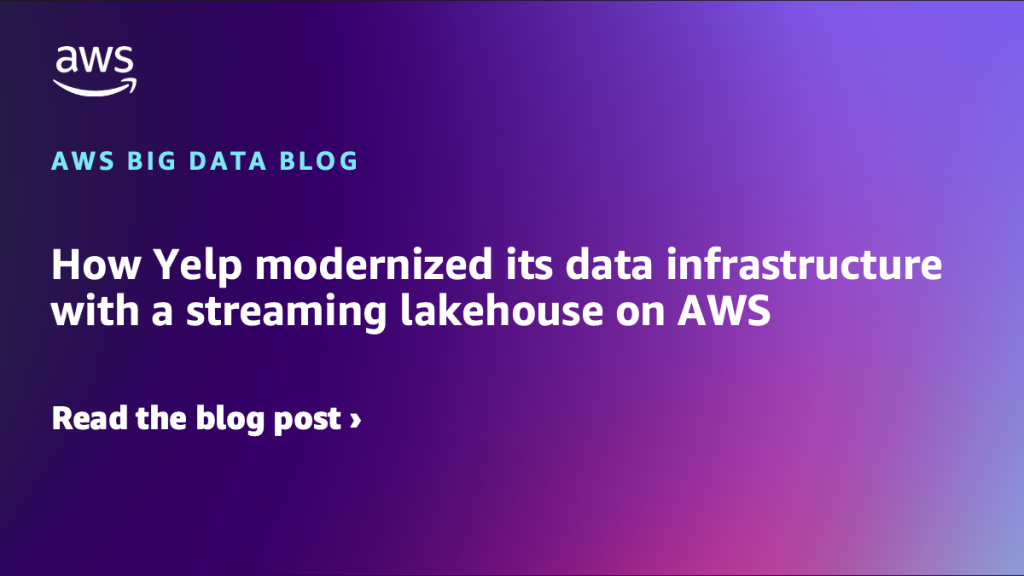AWS Big Data Blog
Category: Architecture
How Yelp modernized its data infrastructure with a streaming lakehouse on AWS
This is a guest post by Umesh Dangat, Senior Principal Engineer for Distributed Services and Systems at Yelp, and Toby Cole, Principle Engineer for Data Processing at Yelp, in partnership with AWS. Yelp processes massive amounts of user data daily—over 300 million business reviews, 100,000 photo uploads, and countless check-ins. Maintaining sub-minute data freshness with […]
Create an OpenSearch dashboard with Amazon OpenSearch Service
This post demonstrates how to harness OpenSearch Dashboards to analyze logs visually and interactively. With this solution, IT administrators, developers, and DevOps engineers can create custom dashboards to monitor system behavior, detect anomalies early, and troubleshoot issues faster through interactive charts and graphs.
Revenue NSW modernises analytics with AWS, enabling unified and scalable data management, processing, and access
Revenue NSW, Australia’s principal revenue management agency, successfully modernized its analytics infrastructure using AWS services. In this blog post, we show how the organization transformed its on-premises data environment into a unified, scalable cloud-based solution using Amazon Redshift, AWS Database Migration Service, Amazon AppFlow, and AWS Glue.
How Stifel built a modern data platform using AWS Glue and an event-driven domain architecture
In this post, we show you how Stifel implemented a modern data platform using AWS services and open data standards, building an event-driven architecture for domain data products while centralizing the metadata to facilitate discovery and sharing of data products.
Amazon OpenSearch Service 101: Create your first search application with OpenSearch
In this post, we walk you through a search application building process using Amazon OpenSearch Service. Whether you’re a developer new to search or looking to understand OpenSearch fundamentals, this hands-on post shows you how to build a search application from scratch—starting with the initial setup; diving into core components such as indexing, querying, result presentation; and culminating in the execution of your first search query.
Stream data from Amazon MSK to Apache Iceberg tables in Amazon S3 and Amazon S3 Tables using Amazon Data Firehose
In this post, we walk through two solutions that demonstrate how to stream data from your Amazon MSK provisioned cluster to Iceberg-based data lakes in Amazon S3 using Amazon Data Firehose.
Architecture patterns to optimize Amazon Redshift performance at scale
In this post, we will show you five Amazon Redshift architecture patterns that you can consider to optimize your Amazon Redshift data warehouse performance at scale using features such as Amazon Redshift Serverless, Amazon Redshift data sharing, Amazon Redshift Spectrum, zero-ETL integrations, and Amazon Redshift streaming ingestion.
Powering global payout intelligence: How MassPay uses Amazon Redshift Serverless and zero-ETL to drive deeper analytics.
In this blog post we shall cover how understanding real-time payout performance, identifying customer behavior patterns across regions, and optimizing internal operations required more than traditional business intelligence and analytics tools. And how since implementing Amazon Redshift and Zero-ETL, MassPay has seen 90% reduction in data availability latency, payments data available for analytics 1.5x faster, leading to 45% reduction in time-to-insight and 37% fewer support tickets related to transaction visibility and payment inquiries.
Petabyte-scale data migration made simple: AppsFlyer’s best practice journey with Amazon EMR Serverless
In this post, we share how AppsFlyer successfully migrated their massive data infrastructure from self-managed Hadoop clusters to Amazon EMR Serverless, detailing their best practices, challenges to overcome, and lessons learned that can help guide other organizations in similar transformations.
How Flutter UKI optimizes data pipelines with AWS Managed Workflows for Apache Airflow
In this post, we share how Flutter UKI transitioned from a monolithic Amazon Elastic Compute Cloud (Amazon EC2)-based Airflow setup to a scalable and optimized Amazon Managed Workflows for Apache Airflow (Amazon MWAA) architecture using features like Kubernetes Pod Operator, continuous integration and delivery (CI/CD) integration, and performance optimization techniques.









